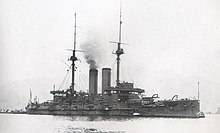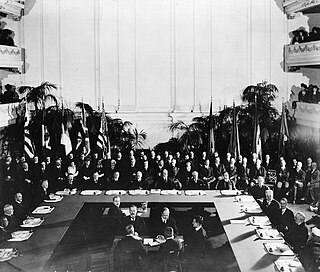
The Washington Naval Treaty, also known as the Five-Power Treaty, was a treaty signed during 1922 among the major Allies of World War I, which agreed to prevent an arms race by limiting naval construction. It was negotiated at the Washington Naval Conference in Washington, D.C. from November 1921 to February 1922 and signed by the governments of the United Kingdom, United States, France, Italy, and Japan. It limited the construction of battleships, battlecruisers and aircraft carriers by the signatories. The numbers of other categories of warships, including cruisers, destroyers, and submarines, were not limited by the treaty, but those ships were limited to 10,000 tons displacement each.

The armored cruiser was a type of warship of the late 19th and early 20th centuries. It was designed like other types of cruisers to operate as a long-range, independent warship, capable of defeating any ship apart from a battleship and fast enough to outrun any battleship it encountered.

The Imperial Japanese Navy was the navy of the Empire of Japan from 1868 to 1945, when it was dissolved following Japan's surrender in World War II. The Japan Maritime Self-Defense Force (JMSDF) was formed between 1952 and 1954 after the dissolution of the IJN.
The Imperial Japanese Navy in World War II, at the beginning of the Pacific War in December 1941, was the third most powerful navy in the world, and the naval air service was one of the most potent air forces in the world. During the first six months of the war, the Imperial Japanese Navy enjoyed spectacular success inflicting heavy defeats on Allied forces, being undefeated in every battle. The attack on Pearl Harbor crippled the battleships of the US Pacific Fleet, while Allied navies were devastated during Japan's conquest of Southeast Asia. Japanese Navy aircraft operating from land bases were also responsible for the sinkings of HMS Prince of Wales and HMS Repulse which was the first time that capital ships were sunk by aerial attack while underway. In April 1942, the Indian Ocean raid drove the Royal Navy from South East Asia. After these successes, the Japanese now concentrated on the elimination and neutralization of strategic points from where the Allies could launch counteroffensives against Japan's conquests. However, at Coral Sea the Japanese were forced to abandon their attempts to isolate Australia while the defeat at Midway saw them forced on the defensive. The campaign in the Solomon Islands, in which the Japanese lost the war of attrition, was the most decisive; they had failed to commit enough forces in sufficient time.
Plan Z was the name given to the planned re-equipment and expansion of the Kriegsmarine ordered by Adolf Hitler in early 1939. The fleet was meant to challenge the naval power of the United Kingdom, and was to be completed by 1948. Development of the plan began in 1938, but it reflected the evolution of the strategic thinking of the Oberkommando der Marine over the two decades following World War I. The plan called for a fleet centered on ten battleships and four aircraft carriers which were intended to battle the Royal Navy. This force would be supplemented with numerous long-range cruisers that would attack British shipping. A relatively small force of U-boats was also stipulated.
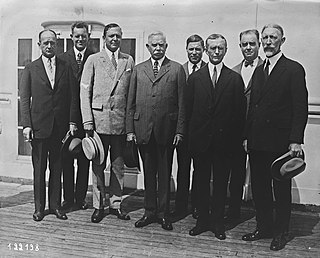
The Geneva Naval Conference was a conference held to discuss naval arms limitation, held in Geneva, Switzerland, in 1927. The aim of the conference was to extend the existing limits on naval construction which had been agreed in the Washington Naval Treaty. The Washington Treaty had limited the construction of battleships and aircraft carriers, but had not limited the construction of cruisers, destroyers or submarines.

Design A-150, popularly known as the Super Yamato class, was a planned class of battleships for the Imperial Japanese Navy. In keeping with longstanding Japanese naval strategy, the A-150s would have carried six 51-centimeter (20.1 in) guns to ensure their qualitative superiority over any other battleship they might face. These would have been the largest guns ever carried aboard a capital ship.

Asama (淺間) was the lead ship of her class of armored cruisers built for the Imperial Japanese Navy (IJN) in the late 1890s. As Japan lacked the industrial capacity to build such warships herself, the ship was built in Britain. She served in the Russo-Japanese War of 1904–05 during which she participated in the Battle of Chemulpo Bay and the Battle of the Yellow Sea without damage, although her luck did not hold out during the Battle of Tsushima. Early in World War I, Asama unsuccessfully searched for German commerce raiders until she was severely damaged when she ran aground off the Mexican coast in early 1915. Repairs took over two years to complete and she was mainly used as a training ship for the rest of her career. The ship made a total of 12 training cruises before she was crippled after running aground again in 1935. Asama then became a stationary training ship until she was broken up in 1946–1947.

Suma (須磨) was a protected cruiser of the Imperial Japanese Navy, designed and built by the Yokosuka Naval Arsenal in Japan. She was the lead ship in the Suma-class cruiser, and her sister ship was Akashi. The name Suma comes from a geographic location near Kobe, in Hyōgo Prefecture.
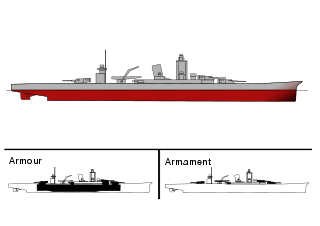
Design B-65 was a class of Super Type A cruisers planned by the Imperial Japanese Navy (IJN) before and during World War II. As envisioned by the IJN, the cruisers were to play a key role in the Night Battle Force portion of the "Decisive battle" strategy which Japan hoped, in the event of war, to employ against the United States Navy.
The Kii-class battleship was a planned class of four fast battleships to be built for the Imperial Japanese Navy (IJN) during the 1920s. Only two of the ships received names. They were intended to reinforce Japan's "eight-eight fleet" of eight battleships and eight battlecruisers after the United States announced a major naval construction program in 1919. However, after the signing of the Washington Naval Treaty in 1922, work on the ships was suspended; one pair was cancelled in November 1923 and the other in April 1924.

The Asama-class cruisers were a pair of armored cruisers built for the Imperial Japanese Navy (IJN) in the late 1890s. As Japan lacked the industrial capacity to build such warships herself, the ships were built in Britain. They were part of the "Six-Six Fleet" expansion program that began after the defeat of China during the First Sino-Japanese War of 1894–95. Between them, the sister ships participated in all four main naval battles of the Russo-Japanese War of 1904–05—the Battle of Port Arthur, the Battle off Ulsan, the Battle of the Yellow Sea, and the Battle of Tsushima—but played a much more minor role in World War I. Asama ran aground while searching for German commerce raiders in early 1915 and was under repair for the next two years. Tokiwa participated in the Battle of Tsingtao (1914) and also searched for commerce raiders. Both ships made training cruises during the war and continued to do so after 1918.
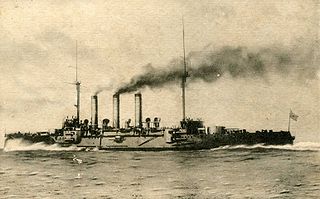
The Izumo-class cruisers were a pair of armored cruisers built for the Imperial Japanese Navy (IJN) in the late 1890s. As Japan lacked the industrial capacity to build such warships herself, the vessels were built in Britain. They were part of the "Six-Six Fleet" expansion program that began after the defeat of China during the First Sino-Japanese War of 1894–1895. The sister ships participated in three of the four main naval battles of the Russo-Japanese War of 1904–1905—the Battle of Port Arthur, the Battle off Ulsan and the Battle of Tsushima—but played a much more minor role in World War I.

The Decisive Battle Doctrine was a naval strategy adopted by the Imperial Japanese Navy prior to the Second World War. The theory was derived from the writings of American naval historian Alfred Thayer Mahan. In the Decisive Battle Doctrine the Japanese navy would win a war by fighting and winning a single, decisive naval action. The idea gained broad acceptance following the Russo-Japanese War, where a well-trained, smaller Japanese naval force gained a decisive victory in the Sea of Japan at the Battle of Tsushima, defeating the Imperial Russian Navy of their rival the Russian Empire, a western naval power. Operational plans thereafter were influenced by the effective naval gunnery Japan demonstrated at Tsushima.
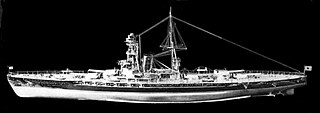
The Tosa-class battleships were two dreadnoughts ordered as part of the "Eight-Eight" fleet for the Imperial Japanese Navy (IJN) during the early 1920s. The ships were larger versions of the preceding Nagato class, and carried an additional 41-centimeter (16.1 in) twin-gun turret. The design for the class served as a basis for the Amagi-class battlecruisers.
The Number 13-class battleship was a planned class of four fast battleships to be built for the Imperial Japanese Navy (IJN) during the 1920s. The ships never received any names, being known only as Numbers 13–16. They were intended to reinforce Japan's "eight-eight fleet" of eight battleships and eight battlecruisers after the United States announced a major naval construction program in 1919. The Number 13 class was designed to be superior to all other existing battleships, planned or building. After the signing of the Washington Naval Treaty in 1922, they were cancelled in November 1923 before construction could begin.

The Satsuma class was a pair of semi-dreadnought battleships built for the Imperial Japanese Navy (IJN) in the first decade of the 20th century. They were the first battleships to be built in Japan and marked a transitional stage between the pre-dreadnought and true dreadnought designs. They saw no combat during World War I, although Satsuma led a squadron that occupied several German colonies in the Pacific Ocean in 1914. Both ships were disarmed and expended as targets in 1922–1924 in accordance with the terms of the Washington Naval Treaty of 1922.
The Eight-Eight Fleet Program was a Japanese naval strategy formulated for the development of the Imperial Japanese Navy in the first quarter of the 20th century, which stipulated that the navy should include eight first-class battleships and eight armoured cruisers or battlecruisers.
